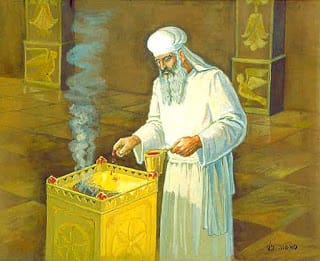The Coming Week’s Daf Yomi by Rabbi Adin Steinsaltz
This essay is based upon the insights and chidushim (original ideas) of Talmudic scholar Rabbi Adin Steinsaltz, as published in the Hebrew version of the Steinsaltz Edition of the Talmud.
This month’s Steinsaltz Daf Yomi is sponsored by Dr. and Mrs. Alan Harris, the Lewy Family Foundation, and Marilyn and Edward Kaplan
Chagigah 27a
Today’s Daf Yomi is dedicated in honor of the yahrzeit of Marsha J. Kaplan (16 Iyar)
Among the Temple vessels mentioned in the Mishna were the altars, which were made of wood encased in metal. The outer mizbe’ach was covered in copper, while the inner one was covered in gold. Masechet Chagigah concludes on our daf with Reish Lakish using the golden altar as a metaphor that teaches how Jewish people, even if they are sinners, are protected from the fire of Gehinnom. He argues that just as the altar, whose gold plate is no thicker than the thickness of a dinar (a type of coin), was not affected by the continuous fire that was on it, similarly Jewish people are protected, since even the sinners among them are full of mitzvot. To support this idea, he points to a passage in Shir ha-Shirim (4:3) for which he offers an alternative, Midrashic reading. Instead of rakatekh (which would mean “your temples are like a pomegranate”), he suggests we read reikanim she-bakh (meaning that even those Jews who appear to be empty of mitzvot are filled with them like a pomegranate is full of seeds).
The Sefat Emet explains Reish Lakish’s statement by reminding us that the Torah is referred to as gold (see Tehillim 19:11), which protects the individual as it does the altar. He also ties this in with statements made earlier in the Masechet that emphasize how all Jews are seen as righteous and reliable during the period of the pilgrimage holidays.
In a similar vein, the Gemara quotes Rabbi Abahu in the name of Rabbi Elazar who teaches that Torah scholars will not be affected by the fires of Gehinom. Just as the salamander, as a creature of fire whose blood can be used to protect an individual from fire, is safe from being burned, similarly Torah scholars, who are seen as creatures of fire, are protected. The idea that Torah scholars are made up of fire comes from Sefer Yirmiyahu (23:29), where the word of God is compared to fire.
Salamander is the common name applied to approximately 500 species of amphibians with slender bodies, short legs, and long tails. The common (or “fire”) salamander, salamandra salamander, lives in and around rivers and swamps in Israel and around the world. There is a superficial resemblance to lizards, but they have no scales and their skin is covered with moist mucous. This salamander is mentioned in the same context as the mythical “salamandra of fire,” which is described in the Midrash. Some suggest that the story in the Gemara refers to the common salamander, which was seen as fire-proof because of its moist body; however, the description of this creature in the Midrash cannot be reconciled with that idea.
In addition to his monumental translation and commentary on the Talmud, Rabbi Steinsaltz has authored dozens of books and hundreds of articles on a variety of topics, both Jewish and secular. For more information about Rabbi Steinsaltz’s groundbreaking work in Jewish education, visit www.steinsaltz.org or contact the Aleph Society at 212-840-1166.
The words of this author reflect his/her own opinions and do not necessarily represent the official position of the Orthodox Union.
